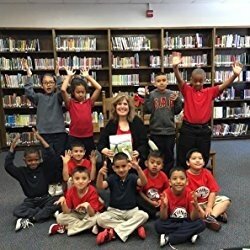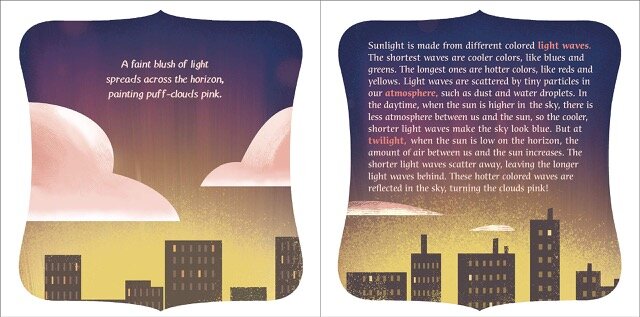Morning, Sunshine! by Keely Parrack, illustrated by John Bajet (North Atlantic Books)
Keely Parrack has been an elementary school teacher in Nottingham, England, a science and language arts specialist, a day care director, a fashion retail manager, a waitress, a supermarket shelf stacker. and a freelance writer with work published in The Christian Science Monitor, The Contra Costa Times, Patch, Spider Magazine and mothering.com. Her best student job was at the movie theater, where she got to watch all the films for free. And now the British native, who lives in San Francisco with her husband, her son and a very demanding cat, has a new favorite grown-up job: debut picture book author. We’re glad Keely dropped by to share the unexpected literary twists and turns that led to Morning, Sunshine! Welcome, Keely!
What inspired you to write Morning, Sunshine!?
I was waiting on some feedback from my agent on a novel I’d written, so I had a little breathing space. And during that sitting around daydreaming time, I started noticing all the creatures that visited our garden; salamanders, hummingbirds, bees, butterflies, squirrels, and I started writing poems about them for fun. Then I figured, I could make a picture book about a day in the garden, from dawn to dusk. But that seemed like such a long time, and to be honest, where I live it is quite hot in the middle of the day, so not much happens, which makes for a pretty boring story! Then an editor I chatted to suggested I narrow the time frame down. This idea worked really well for haiku, too. All I needed to decide then was which creatures and what time period. I love dawn, it’s a magical time of the world waking and always seems so full of possibility, so the that’s how the idea of Morning, Sunshine! taking place from dawn to sunrise came about!
Good Morning, Sunshine! by Keely Parrack, illustrated by John Bajet (North Atlantic Books)
Did you start off with this fascinating structure — a haiku about a creature, or aspect of nature, followed by a page of information? How did you come up with the idea to tell the story this way?
I love science and nature, and when I was a teacher, the children I worked with did, as well. So I always wanted to have poems supported by facts. But I wasn’t sure for a while if the facts should come after the poems as back matter, or on the opposite page, as sidebars. In the end, I figured that the haiku were so small and focused that the back matter should just concentrate on the questions raised in the poems, so then it made more sense to have them together on the same spread, like a question and answer!
One of Keely’s inspirations for Morning, Sunshine! was this swaying mourning dove with her brood, nesting in the Parrack family hanging basket (photo by Keely Parrack)
In your back matter, you teach children how to write haiku and share how fun it is. When did you first learn to write and like haiku?
I have always written poetry for fun. My mom still has a faded one I wrote when I was six about a mouse. I really don’t remember when I first wrote haiku, to me it’s just a fun challenge—can you stick to just three lines, use 17 syllables total, and still say everything you want to say? It’s like a puzzle, and so satisfying when you make it work! I think children like playing with haiku as they are small, as it’s not intimidating and has understandable rules! (Haiku, not children!)
Keely’s very demanding cat contemplating her review of Morning, Sunshine! (photo by Keely Parrack)
Why did you pick the creatures you did? Do you have any favorites that you had to leave out of the final text?
I started with a whole load of poems, but knew I had to limit the number of creatures and events, to fit the number of pages I had to play with. My editor and I quickly realized we had to keep three things in mind for the books structure to work.
1 – the settings are in a repeated pattern, suburban, urban, rural.
We wanted it to be inclusive, representing urban, suburban and rural areas, so every child could see something similar to their own environment.
2 – dawn to sunrise timeline
The creatures had to appear in the order that they would, no bees at dawn, or dawn chorus at sunrise!
3- variation of subject
The creatures and natural events needed to be spaced out from each other, so no bird after bird or insect after insect.
We built a spread sheet to figure it all out and some of my favorite creatures had to go, like butterflies and raccoons. But they were replaced by some wonderful creatures like foxes and deer. It was a tough call!
Do you have your own favorite dawn-time creatures? Did you get up early up to watch some for research (and fun)?
One of my favorite experiences writing this book was getting up really early and going down to the end of an area nearby, where the road ends and turns into scrub land. There are a lot of houses, then a small patch of land with some trees and a grass walkway, next to a fenced-off water reservoir and a lot of overgrown bushes. While I was waiting for the sun to rise, rabbits hopped by my feet and birds called across the water, then suddenly from nowhere a deer family stepped out of the shadows. It was amazing, they’re so big up close, and to just step out from the shadows and suddenly be there seemed like a miracle. And that’s how the deer haiku pretty much wrote itself!
One of Keely’s inspirations: deer at dawn by her home (photo by Keely Parrack).
Some picture book writers shy away from challenging words, but I see you have found a way to introduce new words in context and have followed up with a rich glossary at the back. Was that part of your initial concept, too? Was it difficult to figure out which big words to feature?
I have always been a big fan of not dumbing down for kids, so I always wanted a glossary, plus words are so much fun! The words were ones I thought could either use a little more explanation and context or were just excellent words that are wonderful to say like ‘crepuscular’ and binky! I do think there’s a sort of magical power in words, and it’s great fun to discover new ones. And here’s a secret, I’m actually a terrible speller, so having a glossary to quickly refer back to, for me as a child, was always wonderful!
What was your writing journey like from idea to finding a home for your manuscript?
It was a long and winding road, with many different versions being written then abandoned. It started out as just fun for me, then every time I showed it to my writer friends, they’d love it, which gave me the motivation to carry on. But I mostly worked on other things and had stopped even thinking about it until an editor at North Atlantic Books mentioned they were looking to expand their children’s books. asked if they would be interested in a non-fiction picture book written in haiku that took place from dawn to sunrise and she said yes, send it! From then it was full speed ahead.
Morning, Sunshine! by Keely Parrack, illustrated by John Bajet (North Atlantic Books)
Were you surprised by any of John Bajet’s drawings? Do you have any personal favorites?
The team at North Atlantic Books were wonderful to work with and kept me very involved with the whole choosing the illustrator process, so I already knew how much I loved John Bajet’s work, but I was still surprised in a wonderful way when I got an actual copy of Morning, Sunshine! His art really brings the words alive, and I love the richness of his colors and textures. There are so many gorgeous details!
How does it feel to have a brand new picture book out in the world? Any feedback from your husband, son or cat?
It feels surreal and wonderful to have a book out in the world, but the best part is sharing it with children and talking about creativity and nature with them. My husband and son are super happy and proud about it. My cat loves it but feels she should really get more credit, being my constant writing companion and muse. As it came out during Covid lockdown she did have her own Morning, Sunshine! social media book tour around our house, which I think she enjoyed very much!
This snail was one of Keely’s inspirations for her book (photo by Keely Parrack)
As a former elementary school teacher, how do you envision teachers using Morning, Sunshine! In the classroom?
I’m thinking as a teacher here, and how we would have used it in the school I used to teach in. We worked very collaboratively and built a theme-based curriculum together for years K, 1 and 2, so with Morning, Sunshine! as the inspiration, in music, we’d make our own dawn chorus bringing in different instruments, ‘birds’, in one by one until we were all playing together then gradually reducing it down again. For science, we’d go on nature walks around the school grounds, taking notes and drawings of our findings, maybe even recording the sounds we could hear, then coming back to the classroom, sharing findings, asking questions – what did we see, where, why do we think they were there what were they doing etc. We’d explore our local geography, maybe build a map, what do suburban, urban, and rural places look like, what do they have in common? What are the differences? Why could that be? For math lots of sorting creatures with the same number of legs, paws, wings etc. and multiplication, addition and subtraction of different creatures with different variables, such as amounts of legs, number of wings, etc. For Earth science we’d investigate light and sound waves, as well as how and why the sun appears to move across the sky, how the and moon and Earth orbit, and where the Earth’s axis and equator are and why! And of course artwork, both creative art and observational drawings. Oh, and we would build a shared role play area as a garden or a forest with the children, for them to play discovering nature in!
All of that without even getting started on the language art elements of creative writing, poetry, note taking, fact finding, and discussions!
So far, I’ve used Morning, Sunshine! to talk to children in grades K-5 about nature and poetry, and children in grades 6-8 to explore the creative writing process, and both have been equally engaged.
What do you hope children will find in the book?
Hope, a fascination with nature, and a lot of fun!
Anything you’d like to add?
My website has downloadable materials for anyone to use, including a nature notebook, and how to fun sheets on how to make a spider and a snail out of paper bag handles!
Thanks, Keely! Be sure to visit Keely on social media.
On her website: keelyparrack.com
On Facebook: Keely L Parrack
On Twitter: @keelyinkster
On Instagram: @keelyinkster
Downloadable resources on Keely’s website: click here
Connect with Keely on social media!
On her website: keelyparrack.com
On Facebook: Keely L Parrack, Children’s Book Author
On Twitter: @keelyinkster
On Instagram: keelyinkster








